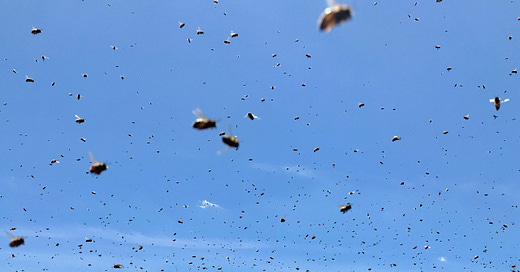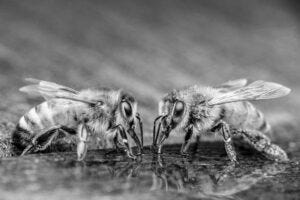I entered the roadside gate of the hayfield, stepped hard on the tractor’s rear, left wheel brake, and sharply turned the front wheels to begin mowing next to the fence. I released the hydraulic lever allowing the seven-foot sickle bar to belly flop on the ground, engaged the power take-off lever to power the mower, and drove forward. The clickity-clack sounds of the sickle moving back and forth were hypnotic and reassuring.
During the first pass, I noticed a lot of bumblebees foraging the clover blooms. Some flew by and circled back, close enough that I heard their deep buzz over the sound of the tractor. I started constantly swiveling my head to make sure they weren’t after me and to keep the big tractor tire away from the fence.
Holy crap, a lot of angry bumblebees are flying around here, I thought, nervously holding the bill of my baseball cap and ready to counter a sneak bee attack. If they land on me, they will sting me. Hoping for mercy is a fool’s hope. Protect and defend. Act, don’t react, I told myself.
My job that afternoon was mowing an 11-acre hillside stand of red clover, timothy, oats, and smooth bromegrass with the M Farmall tractor bolted to a pull-behind mower. The mower was an IH-McCormick Farmall No.27V sickle bar mower made in the 1950s. The frame was V-shaped ending with a free-spinning tail wheel at the end for support.
After morning chores, lunch and Dad’s customary 30-minute midday nap, he told me to grease the mower and head over to the hayfield. “You should be able to finish mowing by 4 pm. Then you can drive to town for baseball practice,” he said, knowing that my school learner’s permit saved Mom a 28-mile round trip.
On the second pass, I reversed direction and drove on mown hay from the first round. Bumblebees were flying around the hay that was lying flat on the ground. If the bees are simply feeding on the flowers, then they really shouldn’t be flying over downed hay in circular patterns, I anxiously reasoned. I turned my head and immediately grabbed the bill of my cap, my carry-on bee weapon. Three or four bees were sneaking up behind me. I quickly adjusted my steering, prepared myself for battle, and glanced back, but they were gone. Maybe I imagined them, I thought. You need to settle down and quit making a big deal out of nothing. “Ignore them,” my dad once told me, “and they won’t bother you.”
Two weeks before, a grizzled, tobacco-chewing neighbor told me how to avoid getting stung by bumblebees. “If you disturb or run over a nest of bumblebees, don’t move a muscle. Don’t be scared when they buzz your face. Don’t even try to steer the tractor until you get out of their attack zone. If you stay perfectly still, they will never sting you,” he said with confidence.
This passive approach had never occurred to me. This was a new, easy method to avoid bumblebee stings and timely advice for the bumblebee season, I thought.
I was mowing shirtless that day to avoid catching hay chaff in a collar that rubbed and itched my skin. The only piece of clothing above my belt during hay season was my frayed, grease-stained “Pfister Hybrids” baseball cap. Dad gave me the hat from his supply of Pfister hats that he used to reward customers who bought seed corn from him. The yellow background of the company logo on my blue hat was dirtied and faded, which I preferred. I didn’t want bees to mistake a clean, bright yellow hat logo for a flower! Pfister Hybrids no longer exists, a victim of extensive mergers with major chemical companies over the last five decades. To this day, we still keep Dad’s old Pfister hat hanging in our family farmhouse more than 25 years after his death.
If I had to fight stinging pollinators, I preferred bumblebees for several reasons. You could hear them coming up behind you or flying by your ears as they checked out landing sites. They sounded like B29 bombers in WWII movies on TV. Their “buzz” resembled the low rumble of giant aircraft, hiding in the clouds on their bombing run.
Bumblebees are big, relatively slow flyers and the yellow patch on their bodies is easy to spot, making them simple to see in my peripheral vision. Wasps and hornets are camouflaged in dark colors and are fast, like fighter planes. I would be in a world of hurt if a squadron of them landed on me. They could land, sting, and escape before I could reach my hat. At least I was fighting bumblebees in this field and not hornets, I reassured myself.
On the third mowing pass, all hell broke loose. The front tires ran over a large bumblebee nest. A formation of bees boiled out of the hidden nest and attacked the growling, iron monster. The big bombers were attacking the motor, the radiator, the tires, and me, when I passed over the disturbed nest. I had no illusions about the 30-to-one odds against me. There were too many to defend myself with my hat. And then I remembered my neighbor’s advice, “If you don’t move a muscle and stay absolutely still…”
I locked my hands on the steering wheel in a death grip and looked straight ahead. I focused on the tree line in the distance to keep my head from moving and prayed that the neighbor was right. Five feet, then 10 feet, from the nest I moved. They were flying all around me but not landing on me. This crazy idea of the neighbor’s was working, the bees can’t see me, I thought. The tractor was off course now, gradually aiming downhill toward the fence, but I didn’t move. I needed just a little more distance from the nest.
Fifteen seconds later, the looming fence forced me to turn the steering wheel, but nothing happened. I slowly relaxed, now glad to have a new tactic to avoid getting stung. That’s when I felt the tip of a feathery brush touch my ear just behind the lobe. Immediately, I let go of the steering wheel with my right hand and scraped the back of my ear. I felt no bee. A second later, my mind registered the sting. The pain grew and throbbed, erasing all doubt about whether the bee had succeeded.
I continued mowing, thinking what I would tell the grizzled neighbor when I saw him. I rehearsed my comments in the next 10 minutes and all versions started out, Your advice of being absolutely still to avoid bumblebee stings isn’t worth a tinker’s damn.
What do you mean? I envisioned the neighbor asking. You must have moved, he said.
I didn’t move a muscle and still got stung. Your little theory didn’t work. None of your passive nonsense for me. From now on, I’m going down fighting. If they attack me, some are going to pay.
And for each of the next several rounds, my hat was locked, loaded, and discharged. The ensuing rounds unleashed more armies of bees, new ones from disturbed nests and ones from the previous round scouting for revenge. My life for the next 45 minutes was driving with one hand and swinging my hat with the other, ears twitching for bombing runs, eyes darting ahead, behind, and around me. My skin sensitivity to touch increased 10-fold. My body became a magnetic field to detect all disturbances. Good thing, too. Five bees landed on various parts of my body on separate occasions, but I swatted them before they had a chance to fire. I averaged five to six bee kills for every nest I drove near.
With my adrenaline surging, the odds of surviving started to overwhelm me. I can’t be this lucky forever, I thought. And then doubt, the offspring of mental and physical stress, started its grip. No, you can’t do this. Yes, you can do this. Quit! No, keep going! This is the last round. Okay, maybe one more round, I told myself. Every round, every minute was danger.
The last round finally defeated me. Two bees hit my face at once. I let go of the steering wheel and fought with my cap in one hand and an open hand in the other. Luckily, no sting. I rubbed the welt behind my ear lobe where the bee had stung me earlier. It itched and burned. Rubbing seemed to mask the throbbing pain. Five minutes later I approached the road gate and decided to call it quits. I had had enough. Maybe tomorrow this field won’t look so terrifying, I told myself.
I drove home with the tractor in its highest gear, called road gear. The rushing air was soothing and cooled my body from the battle heat built up from fighting bees. I prayed that Dad wasn’t at the farmstead. I didn’t want to face him. I knew what he would think of me when I returned though nothing was broken, just my spirit. I bet he is going to call me, “Chickenshit,” I predicted. And he would be right. I didn’t want to face the angry bees anymore.
I had quit when the going got tough. That went against my parents’ rule, a rule that I perceived as unshakable. I felt pathetically weak and emotionally drained. I had fought an army of bumblebees, they had wounded me, and I had lost the battle. And 10 acres were left to mow, by me, a person who lacked the courage to meet the challenge. During the last two miles home, I began to imagine my life with a new nickname, “Chickenshit.”
\
This is an excerpt of a longer essay first published in The Blazing Star Journal. You can read more here:
Russ Mullen is Professor Emeritus of Agronomy, Iowa State University. He was a scientist and educator during his 41-year university career.
He is a lover of agriculture, outdoors, nature’s art and biodiversity.
I am happy to be a member of the Iowa Writer Collaborative. Please read and support my colleagues, especially Lea Donahue, as we welcome her to the group.












Russ, I enjoy your stories and your writing style!
I gasped and even laughed out loud (because the story is so well-told, not because you got stung) as I sat on the edge of my seat, and you better believe I clicked for more.